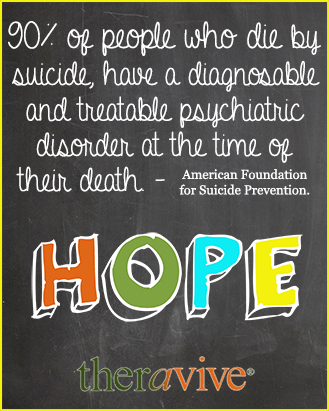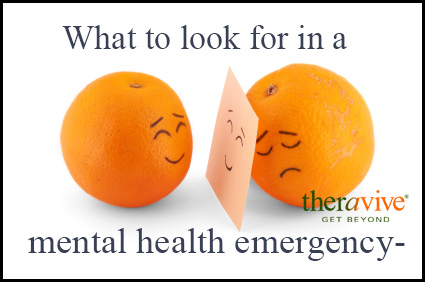June 13, 2018
by Tina Arnoldi

The American Foundation For Suicide Prevention offers guidelines for journalists on how to cover suicide cases, especially with well-known personalities who have instant name recognition with a majority of people.
[More]
A young African-American woman was excited to finally land the job of her dreams. Though, she would be traveling some distance from her home town, she was ecstatic about the opportunity. Little did she know that she would never have the chance to start the job. On July 13, 2015, the woman was found dead in a prison cell. Where did it all go wrong? How did this young aspiring woman end up in jail and dead?
[More]
While the signs and symptoms of depression are the same for adolescents and adults, depression in teens often presents very differently from adults (ibid.). It is imperative, therefore, for parents, teachers, and professionals involved with adolescents to know the different ways teens show their depression.
[More]
December 19, 2014
by Marti Wormuth, MA

Suicide is one of those things that many people don't like to talk about because it's a very painful thing to talk about. Some of us know people who have thought about suicide, or we may know someone who has attempted or succeeded at it. Because of that, it's more important than ever for us to understand how we can help people who are struggling through this painful thing. In this article, we're going to look at the reasons that someone would consider suicide and how you can help.
[More]
November 13, 2014
by Marti Wormuth, MA

One of the most difficult things to deal with in life is losing someone that you love. But when they take their own life in some way, the suffering becomes that much worse for those left behind. Questions go through your mind and you aren't totally sure how to deal with it. And that's okay - it's hard to be the people that are left behind from such a painful experience. International Survivors of Suicide Day is November 15th, and this day is to help people realize that they are not alone in this journey, and that they do not need to feel afraid.
[More]
July 14, 2014
by Cathy England, MA

Mental health emergencies can occur both in individuals who are receiving treatment, and in those who have never had a mental health issue in the past. The difference between a need for treatment and an emergency can be difficult to discern. However, there are some well documented warning signs that can help to determine what type of intervention is best suited to an individual.
[More]
November 11, 2013
by Ashley Marie

Remembrance day is a chance for us all to reflect on our heroes. This heartfelt story gives us an important reason why it is good for us to remember.
[More]
September 10, 2013
by Ashley Marie

September 10 is World Suicide Prevention Day.
On this day, governments lead new initiatives to help prevent suicide, conferences and lectures are provided to raise awareness about suicide, and candlelight ceremonies are held in remembrance of those who died from suicide.
Suicide and suicidal thoughts affect individuals all across the globe. According to the World Health Organization (WHO), about 1 million people commit suicide every year.[1] On average, this means that someone dies from suicide every 40 seconds and someone attempts to commit suicide every 3 seconds.
These statistics are tragically high. The WHO estimates that more people die from suicide than from armed conflicts. For teenagers and young adults, suicide is one of the primary causes of death. Suicide also tends to be more common among men than women.
Country with the Highest Suicide Rate
The country with the highest rate of suicide in the world is Greenland.[2] Even Japan, a country that has a history of high suicide rates, has 51 suicides per 100,000 residents. In Greenland, 100 die from suicide per 100,000 inhabitants.
This mental health issue is so widespread that just about everyone in Greenland knows someone who has committed suicide. And this is a historically recent phenomenon. In the early 1900s, this country’s suicide rate was merely 0.3 people per 100,000 residents. This rate dramatically increased in the latter part of the 20th century, especially in the 1970s and 1980s.
Researchers argue that residents of Greenland employ suicide methods that allow for a low chance of survival. 9 in 10 men commit suicide through shootings or hangings, and this method of killing also applies to 7 in 10 women.
It is difficult to determine why suicide is so prevalent in Greenland. Some theorists suggest that it can create a vicious cycle; once one person commits suicide, others may become more inclined to do the same. Some point to Greenland’s issues with poverty. Others highlight that 88% of the country’s population is Inuit, and much like North America, many of them suffer from alcoholism. Though Greenland has very harsh winters (which could contribute to depression), studies show that the highest rates of suicide occur in the summer.
Suicide in North America
Though suicide is not as prevalent as it is in Greenland, the United States and Canada continue to suffer from suicides.
In 2009 in the United States, there were 36,909 deaths from suicide – and this number is higher for men than women, as well as for people of color than Caucasians.[3] (For more information about the relationship between minority groups and mental health issues, read What Can You Do to Raise Awareness?). Between 2008 and 2009, suicide was the only leading cause of death in the United States that showed a significant increase. Suicide is the 10th leading cause of death for Americans, and there are 12 suicides per 100,000 residents.
Similar to the United States, in 2009 Canada’s suicide rate was 11.5 suicides per 100,000 residents. In Canada, the highest rates of suicide occur among those between the ages of 40 and 59, and suicide is again more common among men than women.
Suicide Rates: Men Versus Women
Again and again, studies have found that suicide rates tend to be higher among men than women.
This is a difficult pattern to explain, but Payne et al. suggest that our socially constructed notions of masculinity and femininity may have an effect on suicidal behaviors. Because male gender roles focus more on strength and risk-taking behaviors, men may be more likely than females to commit suicide.[4] Men might also feel more pressure to be ambitious and successful, which can lead to depression in times of economic turmoil and higher rates of unemployment. This is especially difficult when men feel the need to provide for their family.
Therapy to Help Prevent Suicide
Suicide is a serious mental health issue, but there are ways to help prevent it. Active Minds is an organization that aims to raise awareness and provide support for suicide prevention. They stress the importance of seeking help if you or someone you know suffers from suicidal thoughts or behaviors. They have a 24-hour suicide prevention lifeline (1-800-273-TALK or 1-800-273-8255) if you or someone you know needs to talk to someone. Long-term therapy is also highly recommended for those suffering from suicidal tendencies.
According to WHO, friends and family members of those contemplating suicide should also look for warning signs. If you discover that someone you know is threatening to harm him or herself, do not hesitate to seek help.
[1] Suicide. 2013. World Health Organization. [online] Available at: <http://www.who.int/topics/suicide/en/> [Accessed 2 September 2013].
[2] George, J. 9 October 2009. The Suicide Capital of the World. Slate. [online[ Available at: <http://www.slate.com/articles/news_and_politics/dispatches/2009/10/the_suicide_capital_of_the_world.single.html#pagebreak_anchor_2> [Accessed 2 September 2013].
[3] Kochanek, K.D. et al. 29 November 2011. National Vital Statistics Report, v 50 no 3. [online] Available at: <http://www.cdc.gov/nchs/data/nvsr/nvsr60/nvsr60_03.pdf> [Accessed 2 September 2013].
[4] Payne et al. 2008. The social construction of gender and its influence on suicide: a review of the literature. Journal of Men's Health. [online] Available at: <http://www.sciencedirect.com/science/article/pii/S1875686708000146> [Accessed 2 September 2013].
February 18, 2010
by Carlton Brown

By Carlton Brown, M.Sc., M.Div., RMFT
A man in Austin, Texas, today flew his small plane into an IRS building, killing himself and possibly one person on the ground, damaging the building, sending people to hospital, and traumatizing hundreds of spectators by conjuring images of a repeat of 9/11. Air force jets were scrambled, and the president was notified. Everyone quickly calmed down when they realized it was “only” a suicide.
The one thing this man made clear before he died was his belief that the world had not treated him fairly. He was mad at the tax department, specifically, as well as “big business” and the government in general. At 53, he must have felt like a failure, having lost two previous businesses and at least one previous marriage. Believing that “insanity is doing the same thing over and over again and expecting a different result”, he twisted this usually helpful aphorism into the conclusion that this would be “something different” to try with his life. Feeling that he had explored all the options, he concluded that “violence not only is the answer, it is the only answer”. At some level, he must have believed that he was “answering” the unfairness of the tax department by making people who worked for the tax department suffer. He was being unfair to them as he had felt that they had been unfair to him.
A good study on suicide is Kay Redfield Jamison’s Night Falls Fast: Understanding Suicide, available here. A professor of psychiatry, Jamison also suffers from bipolar affective disorder, a mental illness associated with a higher risk of suicide. She knows whereof she speaks.
Suicide has been called “a permanent solution to a temporary problem”. When people contemplate suicide, they feel hopeless and
helpless. Without resources and without a future, people on the verge of completing suicide reportedly feel a sense of calm, as if they have “solved” their problem with this very narrow and final solution.
People who contemplate suicide are usually depressed. Depression can be part of bipolar disorder as well as an illness unto itself, and is associated with defective thinking. Depressed people make three errors in their thinking: first, they think that they are worthless; second, they think that the world is unfairly punishing them; third, they don’t think that things will ever get better. This man probably had all three of these faulty thoughts, writing most clearly about the second, that he felt that he had been treated unfairly. He certainly didn’t seem to believe that things were going to improve. And he counted his own life as worthless in his plan to right the wrongs that had been done to him.
It is not unusual for people to have suicidal thoughts. Depression in and of itself may even be part of a normal life, a time of lying fallow and resting, perhaps to recover from a trauma or a loss. Matthew Fox called it one of the four roads that we follow from time to time in the course of life. But it isn’t meant to be the main road that we take - not the main course. After a period of depression it is indeed helpful to “do something different” - but not to fly your plane into the government office of your choice. Distraction has been shown to help people recover from depression. Forcing yourself to do a normal routine also helps: “fake it til you make it” is a good mantra to follow. Because if you do manage to distract yourself from your thoughts, if you do “fake it” and go on about life “as if” it is worth living, it will become so again.
It is not unusual to have such thoughts. The time to worry, however, is when you find yourself (or someone you know) beginning to develop plans. Suicidal thoughts + plans = risk, especially if the plan is within the person’s ability to be carried out in the near future. This constitutes an emergency: it’s time to call 911 and get the person to hospital, where someone can distract them until they are able to distract themselves.
Before it becomes an emergency, however, if you find your life becoming a knotted problem from which there seems to be no escape, find a good therapist. Therapists are trained to “open space” and generate additional options - solutions to your problems that perhaps you never thought of. Certainly for this man, there were options besides exacting an eye for an eye from the tax department, in a permanent and fatal solution. It was tragic that he couldn’t see these options.
A great online resource for preventing suicide is here.